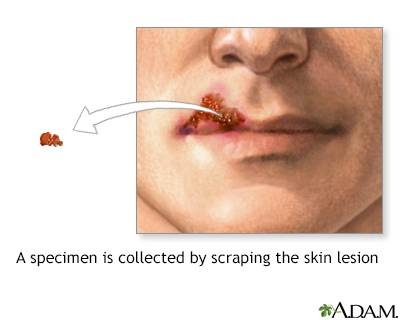Herpes viral culture of lesion
Culture - herpes simplex virus; Herpes simplex virus culture; Herpes zoster virus culture
Herpes viral culture of a lesion is a laboratory test to check if a skin sore is infected with the herpes virus.
Images

How the Test is Performed
The health care provider collects the sample from a skin sore (lesion). This is done usually by rubbing a small cotton swab and on the skin lesion. Sometimes blisters may have to be opened in order to be cultured. The sample is sent to a lab. There, it is placed in a special dish (culture). It is then watched to see if the herpes simplex virus (HSV), herpes zoster virus, or substances related to the virus grow. Special tests may also be done to determine whether it is HSV type 1 or 2.
How to Prepare for the Test
The sample must be collected during the acute phase of infection. This is the worst part of an outbreak. It is also when the skin lesions are at their worst.
How the Test will Feel
When the sample is collected, you may feel an uncomfortable scraping or sticky sensation. Sometimes a sample from the throat or eyes is needed. This involves rubbing a sterile swab against the eye or in the throat.
Why the Test is Performed
The test is done to confirm herpes virus infection. Herpes simplex virus causes genital herpes. It can also cause cold sores of the mouth and lips. Herpes zoster causes chickenpox and shingles.
The diagnosis is often made by physical examination (your provider looking at the sores). The cultures and other tests are used to confirm the diagnosis.
This test is most accurate when a person is newly infected, that is, during the first outbreak.
Normal Results
A normal (negative) result means that the herpes virus did not grow in the laboratory dish and the skin sample used in the test did not contain any herpes virus.
Be aware that a normal (negative) culture does not always mean that you do not have a herpes infection or have not had one in the past.
What Abnormal Results Mean
An abnormal (positive) result may mean that you have an active infection with herpes simplex virus. Herpes infections include genital herpes, cold sores on the lips or in the mouth, or shingles. More blood tests will likely be needed to confirm the diagnosis or the exact cause.
If the culture is positive for herpes, you may have recently become infected. You may have become infected in the past and are currently having an outbreak.
Risks
Risks include slight bleeding or discomfort in the area where the skin was swabbed.
Related Information
AsymptomaticGenital herpes
References
Marks JG, Miller JJ. Dermatologic therapy and procedures. In: Marks JG, Miller JJ, eds. Lookingbill and Marks' Principles of Dermatology. 6th ed. Philadelphia, PA: Elsevier; 2019:chap 4.
Plourde AR, Beavis KG. Specimen collection and handling for diagnosis of infectious diseases. In: McPherson RA, Pincus MR, eds. Henry's Clinical Diagnosis and Management by Laboratory Methods. 24th ed. Philadelphia, PA: Elsevier; 2022:chap 66.
Whitley RJ, Gnann JW. Herpes simplex virus infections. In: Goldman L, Cooney KA, eds. Goldman-Cecil Medicine. 27th ed. Philadelphia, PA: Elsevier; 2024:chap 345.
BACK TO TOPReview Date: 8/23/2023
Reviewed By: LaQuita Martinez, MD, Department of Obstetrics and Gynecology, Emory Johns Creek Hospital, Alpharetta, GA. Also reviewed by David C. Dugdale, MD, Medical Director, Brenda Conaway, Editorial Director, and the A.D.A.M. Editorial team.

Health Content Provider
06/01/2025
|
A.D.A.M., Inc. is accredited by URAC, for Health Content Provider (www.urac.org). URAC's accreditation program is an independent audit to verify that A.D.A.M. follows rigorous standards of quality and accountability. A.D.A.M. is among the first to achieve this important distinction for online health information and services. Learn more about A.D.A.M.'s editorial policy, editorial process and privacy policy. A.D.A.M. is also a founding member of Hi-Ethics. This site complied with the HONcode standard for trustworthy health information from 1995 to 2022, after which HON (Health On the Net, a not-for-profit organization that promoted transparent and reliable health information online) was discontinued. |
The information provided herein should not be used during any medical emergency or for the diagnosis or treatment of any medical condition. A licensed medical professional should be consulted for diagnosis and treatment of any and all medical conditions. Links to other sites are provided for information only -- they do not constitute endorsements of those other sites. © 1997- 2025 A.D.A.M., a business unit of Ebix, Inc. Any duplication or distribution of the information contained herein is strictly prohibited.
